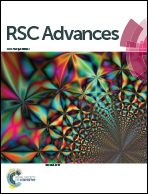Selective heterogeneous nucleation of gold nanoparticles on one-dimensional cadmium silicate for enhanced nonlinear optical responses
Abstract
A facile route to uniformly assemble Au nanoparticles (NPs) on the surface of cadmium metasilicate (CdSiO3) nanowires (NWs) via a heterogeneous nucleation process was demonstrated. Transmission electron microscopy, X-ray diffraction, Fourier transform infrared spectroscopy, and UV-visible spectroscopy were performed to investigate the morphology, structure, and linear optical properties of the Au NPs/CdSiO3 NWs hybrid nanostructure. The results revealed that uniform decoration of the Au NPs on the surface of CdSiO3 NWs could be achieved by heterogeneous nucleation. Compared with the infrared bands of the CdSiO3 NWs, weaker characteristic infrared bands were observed upon assembly of the Au NPs on the CdSiO3 NWs due to an electron intraband transfer process in the 6sp band of the Au species. Additionally, the hybrid nanostructure displayed a red-shifted, relatively broader, and weaker surface plasmon resonance band compared with the Au NPs. These changes in the spectral bands could be attributed to the interparticle inter actions absorbed on the surface of the CdSiO3 NWs. The nonlinear optical (NLO) properties of Au NPs/CdSiO3 NWs were characterized using an open-aperture Z-scan technique with 4 ns laser pulses at 532 nm. The Au NPs/CdSiO3 NWs hybrid nanostructure displayed superior NLO responses than a suspension of carbon nanotubes, a benchmark optical limiter. Furthermore, the CdSiO3 NWs noncovalently functionalized with Au NPs offered superior performance over individual CdSiO3 NWs. The enhancement in NLO properties was mainly attributed to the combination of nonlinear scattering and nonlinear absorption induced by surface plasmon resonance effects by the Au NPs.


 Please wait while we load your content...
Please wait while we load your content...